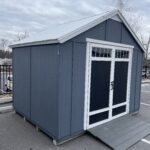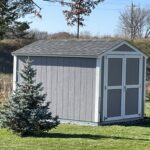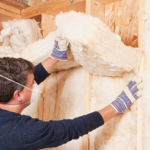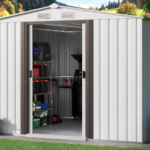Do you have a shocking experience every time you shuffle your sock-covered feet across the rugs that you laid down in your shed, garage, barn, or mancave? Does just thinking about chapped lips cause yours to flake like pie crust? Is your shed starting to resemble Death Valley or the Sahara Desert?
Did you answer yes to any of these? All of these? Sounds like you’re fighting the dreaded dry air monster, my friend. But how do you fix this problem? How do you get rid of the dry air plaguing your structure?
Most people have the opposite problem — too much moisture in their shed or garage. But some people in some parts actually want to add humidity to their building — a foreign concept for those in the Southeast!
Easy Fix to Get Rid of Your Shed’s Dry Air: Humidifier
There are many ways to go about getting rid of dry air in your shed or garage. It all depends really upon just how much of your personal time and energy you want to invest into fixing the problem.
the problem.
If you have no desire to spend any of your time getting rid of dry air, you can go to a big box store or hardware store and purchase yourself one or more humidifiers (depending upon their size and how big your home is). Amazon sells a few single-room units like this humidifier from Pure Enrichment that has a lot of cool features. However, just remember the larger your building the larger a humidifier you’ll need.
You can probably figure out how they work just by their name – they add back the moisture that is so desperately needed in the air. You can get ones with a reservoir that you have to keep filling or there are some really snazzy (read: pricey) ones that you can hook up to a continuous water source like a faucet or hose. Whichever you decide to go with, you will have to clean them, de-scale them, and sanitize them.
It’s super easy to de-scale your humidifier. If you’ve de-scaled a coffee pot, you can clean a humidifier. First, make sure the humidifier is unplugged (naturally). Take off the filter and rinse it under warm-ish water and gently rub any deposits off. Then pour a good amount of distilled white vinegar (the cheapest you can find is perfect) into the tank. By good amount, I mean at least a few cups. Let the vinegar sit in the tank for at least 30 minutes, swishing it around a few times. Pour out the vinegar and scrub any stubborn spots. Rinse really REALLY well. And you’re ready to go again!
rinse it under warm-ish water and gently rub any deposits off. Then pour a good amount of distilled white vinegar (the cheapest you can find is perfect) into the tank. By good amount, I mean at least a few cups. Let the vinegar sit in the tank for at least 30 minutes, swishing it around a few times. Pour out the vinegar and scrub any stubborn spots. Rinse really REALLY well. And you’re ready to go again!
Also, if you use humidifiers, be sure to sanitize the tank, since we all know that bacteria LOVE a warm and moist environment to set up shop in. Once a week or so, toss a teaspoon of either bleach or hydrogen peroxide for every gallon your tank holds and fill your tank with water. Let it sit for 30 minute, drain the tank, and rinse really well. Fill with water and keep adding that wonderful moisture to the air in our home.
If you go with the humidifier, a thing to consider is to scent the air that comes out of the machine. You can either add a few drops of your favorite essential oil to the water in the tank or sprinkle it on the filter. My favorites are lemon, rose, or a blend from Young Living oils called Thieves. Google it. The historical story behind the name is really cool.
But, what if you don’t want to spend beaucoup bucks on humidifiers? Or you like to MacGyver things out of what you have? Fear not. There are so many ways to get rid of dry air.
Best Natural Ways to Get Rid of Dry Air
Keep Vents Closed.
If you built your garage or shed with vents, keeping them closed will help contain a bit of moisture that naturally comes from human activity, pets, or plants. While this may not work for everyone, it is a good first step to try to get 5 or 10% more humidity in the air.
Minimize Heather Use.
Perhaps your shed’s dry air is due to heater use. Heated sheds often use a natural-gas powered heating unit, and they can spew out some pretty dry air. Instead of setting the thermostat to 68, set it to 52. The goal, after all, is to keep things from freezing. You don’t need your shed to be balmy. Just wear a sweatshirt!
House plants help with dry air.
If you have a green thumb (or even a slightly green thumb), you can try growing house plants. They help to add moisture to the air through transpiration – that is, they have tiny little pores on the underside of their leaves where the water that they soak up through their roots escapes. But bear in mind, they need moisture to make this happen.
And if you are a chronic forgetter when watering is concerned, a good idea is to get a shallow tray of some kind and fill it with landscaping pebbles. Place your plants on the pebbles and fill the ray with water up to the bottom of the pots. BONUS! – you get the moisture from the tray of water too!
If you go this route, just don’t get anything that rodents will like. The last thing you want to trade is dry air for having mice in your shed!
Scented simmer pot.
A way that I really like and usually use is to make a scented simmer pot on the stove. A what?! A simmer pot. Basically, find your smallest saucepan and fill it with water and add anything you want to the water to scent it and make the air stink pretty.
If you have a heat source, even a plug-in one, this can be a surprisingly effective option.
I often put in orange peels (or other citrus peels), chunks of lemon, whole spices like cinnamon sticks or cloves or star anise (you can find these at your grocery store), and every so often I might toss in a small bit of cedar. You can buy whole spices like Cinnamon Sticks from Amazon.
You can also add essential oils to the water. The key is to get the pan to a boil and then reduce the heat so low that it just simmers and steam rises from the liquid. And be sure to keep adding water, otherwise you’ll have smoke instead of steam.
Sounds like too much work to babysit a saucepan on the hotplate or stove? No worries – use a crockpot instead! Just add the water and the things you want to make it smell pretty and turn the machine on to low. No fuss, no muss!
This is just the tip of the iceberg when it comes to easy DIY solutions to getting rid of dry air in your home. A good rule of thumb to keep in mind is if there is steam or extra moisture that is produced while doing something, harness it! Make it help you fight all that dry air in your home. And hopefully you can live knowing you are safe from shocking yourself as you walk across your carpets.












